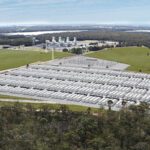A new report released July 31 details continued growth in global energy storage, driven by lower costs for lithium-ion batteries.
Research company BloombergNEF (BNEF) in its latest forecast published Wednesday said energy storage installations worldwide will grow across the next two decades, from the 9 GW/17 GWh of capacity deployed as of last year, to 1,095 GW/2,850 GWh by 2040, as battery costs fall by half by 2030 compared to today’s levels. It said two markets—stationary storage and electric vehicles—will drive demand for batteries.
BNEF said most of the new energy storage capacity for the power market is likely to be grid-scale.
Yayoi Sekine, a co-author of the report, in a news release said the latest research has “two big changes,” noting that “this year … we have raised our estimate of the investment that will go into energy storage by 2040 by more than $40 billion,” with BNEF forecasting $662 billion will be invested in storage over the next 20 years. Sekine, an energy storage analyst for BNEF, said, “We now think the majority of new capacity will be utility-scale, rather than behind-the-meter at homes and businesses.”
‘Energy Shifting’
BNEF’s analysis points to how less-costly batteries can be used in more applications, including “energy shifting,” or moving in time the dispatch of electricity to the grid, often during periods of excess solar and wind generation; peaking in the bulk power system, or using storage to deal with spikes in demand; and programs enabling customers to pay less for their electricity, by enabling the purchase of power at times when it’s cheaper, and storing it for later use.
Several speakers at Storage Week Plus, a July 23-25 energy storage conference in San Francisco, California, attended by POWER, noted how growth in storage likely is dependent on a continuing decline in battery cost, advancements in battery technology, and more applications for storage. Legal and regulatory mandates for storage also will play a role.
Thom Byrne, CEO of the clean energy investment group CleanCapital, told POWER his company is investing in “new markets and new renewable energy asset classes, with a specific focus on distributed solar and energy storage.” Byrne’s group earlier this month announced its largest acquisition to date with the purchase of Olympic, a 75.2-MW solar portfolio comprising 15 operating solar projects in New Jersey, from KDC Solar, a private, non-utility-affiliated owner and operator of large-scale commercial and industrial solar power generation.
CleanCapital’s investments are part of the growth forecast by BNEF. CleanCapital recently closed on a $300 million debt warehouse facility with Credit Suisse, leveraging funds managed by CarVal Investors, a global alternative investment fund manager.
“The debt warehouse facility grants us access to a new type of financing, bolstering our overall capital capacity to acquire distributed solar and energy storage projects,” said Matt Eastwick, CIO at CleanCapital.
Renewables-Plus-Storage ‘Major Driver’
Logan Goldie-Scot, who leads BNEF’s energy storage group, said, “In the near term, renewables-plus-storage, especially solar-plus-storage, has become a major driver for battery build. This is a new era of dispatchable renewables, based on new contract structures between developer and grid.”
BNEF’s forecast notes that just 10 countries will represent about 75% of the global storage market based on gigawatt capacity. South Korea is the leading global market, but BNEF expects the U.S. and China will far outpace the rest of the world by 2040. Other large storage markets include India, Germany, Latin America, Southeast Asia, France, Australia, and the UK.
BNEF’s analysts said, “Demand for storage will increase to balance the higher proportion of variable, renewable generation in the electricity system. Batteries will increasingly be chosen to manage this dynamic supply and demand mix.” It noted that “energy storage will become a practical alternative to new-build electricity generation or network reinforcement. Behind-the-meter storage will also increasingly be used to provide system services on top of customer applications.”
Patrick Milligan, a manager in ICF’s Commercial Energy Division, told POWER: “We agree with BNEF that high levels of variable supply will be the biggest driver for grid-scale storage going forward, and this is true for both paired renewable-battery projects or as standalone plays in these markets. Accordingly, in the U.S. storage has been and will continue to be most heavily deployed in states with the most aggressive RPS targets.” ICF is a global consulting services company.
Milligan continued: “However, we also see large opportunities for storage use in transmission-constrained load pockets for reliability purposes, and eventually as transmission upgrade replacement once the regulatory structures are worked out. Opportunities exist in other areas (such as customer-sited, etc.) but may be smaller in total MW deployed over time.”
BNEF forecasts that total demand for batteries from the stationary energy storage and electric transport sectors is expected to hit 4,584 GWh by 2040. The group said that level would provide “a major opportunity for battery makers and miners of component metals such as lithium, cobalt and nickel.”
The various battery technologies were explored by POWER earlier this year. The U.S. Energy Information Administration (EIA) in a 2018 report said lithium-ion batteries represented more than 80% of the installed power and energy capacity of large-scale battery storage applications. Nickel- and sodium-based batteries represented about 10%; lead-acid and other chemistries made up the rest.
—Darrell Proctor is a POWER associate editor (@DarrellProctor1, @POWERmagazine).










